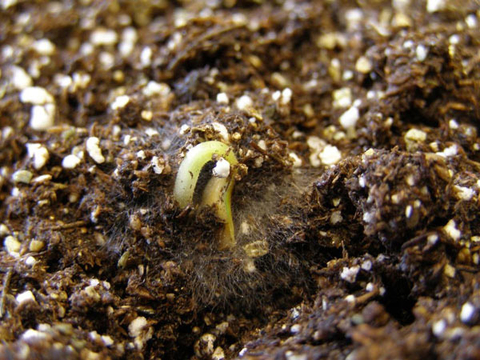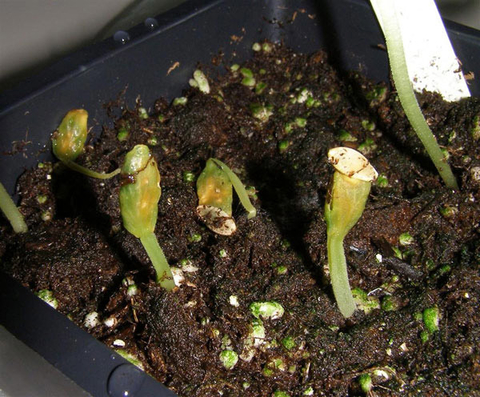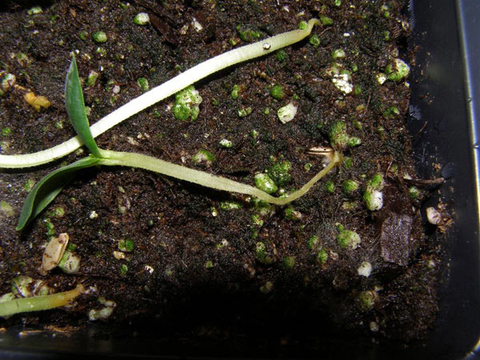Quick facts
- Damping off affects many vegetables and flowers.
- It is caused by a fungus or mold that thrive in cool, wet conditions.
- It is most common in young seedlings.
- Often large sections or whole trays of seedlings are killed.
- It can cause root rot or crown rot in more mature plants.
- Use sterilized pots or trays with good drainage and use clean, new potting soil to prevent damping off.
Damping off is a disease of seedlings
Seedlings infected by damping off rarely survive to produce a vigorous plant. Quite often a large section or an entire tray of seedlings is killed.
Once plants have mature leaves and a well developed root system, they are better able to naturally resist the fungus or mold that causes damping off. There is a critical period of growth between planting and maturity when special care needs to be taken to protect sensitive seedlings.
A wide variety of vegetables and flowers can be affected by damping off. Young leaves, roots and stems of newly emerged seedlings are highly susceptible to infection. Under certain environmental conditions, damping off pathogens can cause root rot or crown rot in mature plants.
The fungi, Rhizoctonia spp. and Fusarium spp., along with the water mold Pythiumspp. are the most common pathogens responsible for damping off.
Identifying damping off symptoms
- Seedlings fail to emerge from the soil.
- Cotyledons (the first leaves produced by a seedling) and seedling stems are water soaked, soft, mushy and may be discolored gray to brown.
- Seedling stems become water soaked and thin, almost thread like, where infected.
- Young leaves wilt and turn green-gray to brown.
- Roots are absent, stunted or have grayish-brown sunken spots.
- Fluffy white cobweb-like growth on infected plant parts under high humidity.
What causes damping off
All of the pathogens (fungi and molds) responsible for damping off survive well in soil and plant debris.
The pathogens can be introduced into the seedling tray in several ways.
- Pots, tools, and potting media that have been used in previous seasons and are not properly cleaned can harbor the pathogens.
- Spores of Fusarium spp. can be blown in and carried by insects like fungus gnats, or move in splashing irrigation water.
- Pythium spp. is often introduced on dirty hands, contaminated tools or by hose ends that have been in contact with dirt and debris.
Once introduced to a seedling tray, the damping off pathogens easily move from plant to plant by growing through the potting media or in shared irrigation water.
Garden soil often contains small amounts of the damping off pathogens. If you use garden soil to fill seedling trays, you could introduce the damping off pathogens that cause the disease into the warm wet conditions best for seed growth.
Seeds planted directly into the garden can also suffer from damping off. Disease is particularly severe when seeds are planted in soils that are too cool for optimal germination or when weather turns cool and wet after planting resulting in slow germination and growth.
The damping off pathogens thrive in cool wet conditions. And any condition that slows plant growth will increase damping off. Low light, overwatering, high salts from over fertilizing and cool soil temperatures are all associated with increased damping off.
Preventing and managing the disease
- Sterilize all used pots and trays in a solution of 10% household bleach by soaking for 30 minutes.
- Use new potting mix to fill trays. Don't reuse potting mix and don't use garden soil or compost.
- Clean all tools that will be used in planting and maintenance of the seedlings. Store them in a clean location when not in use.
- Use a heating pad under trays to warm soil to 70-75°F for indoor plant production.
- Wait until garden soil has reached optimal temperature for germination before planting outdoors. This temperature varies depending on the plant (see the table below).
- Use a potting mix with good drainage. Water to keep it moist but not soggy. Use pots with drainage holes to insure good drainage of excess water.
- Keep hoses and water heads off the floor.
- Use clean warm (68 – 77 F) water to water young seedlings. Cool water (50 F) slows plant growth and increases the opportunity for infection.
- Do not apply fertilizer to seedlings until several true leaves have developed. Then apply 1/4 strength standard soluble fertilizer. Many potting mixes contain slow release fertilizer and do not require any fertilizer application.
- Provide 12-16 hrs of light from a soft white fluorescent or grow light to seedlings. Light from a window is not enough.
Soil temperatures for best seed germination
| Crop | Minimum soil temp | Best soil temp |
|---|---|---|
| Cucumbers, melons, squash | 60 F | 95 F |
| Sweet corn | 50 F | 95 F |
| Peas | 40 F | 75 F |
| Onions | 35 F | 75 F |
| Potatoes | 50 F |
Reviewed in 2024




